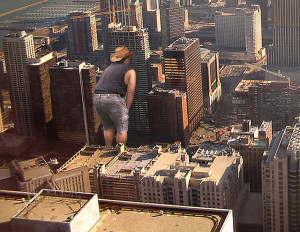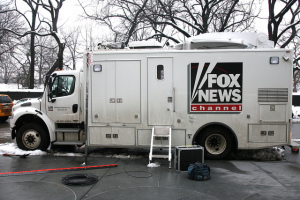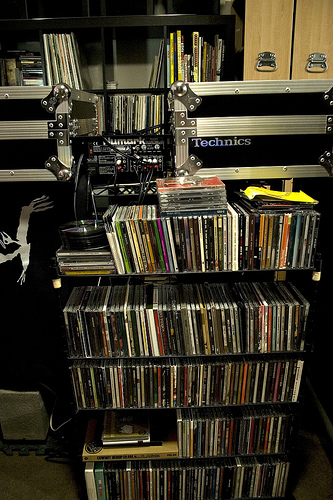 This New York Appellate Division case affirmed the First Amendment right of Defendant, a photographer, over the right to privacy of Plaintiffs’ children, whose pictures were taken surreptitiously using a high powered camera lens and became the subject of an art exhibition. The case is Martha Foster et al. v. Arne Svenson, (2015 NY Slip Op 03068).
This New York Appellate Division case affirmed the First Amendment right of Defendant, a photographer, over the right to privacy of Plaintiffs’ children, whose pictures were taken surreptitiously using a high powered camera lens and became the subject of an art exhibition. The case is Martha Foster et al. v. Arne Svenson, (2015 NY Slip Op 03068).
Defendant Arne Svenson is a photographer. As he explained on his web site, “he has turned outward from his usual studio based practice to study the daily activities of his downtown Manhattan neighbors as seen through his windows into theirs.” The result of this work became the series The Neighbors, which was exhibited in 2013 in New York and Los Angeles, and will be exhibited next year in Denver. Svenson used a telephoto lens,inherited from a bird-watching friend, to take pictures, from his own downtown Manhattan apartment, of people living or working in a building across the street, without their knowledge, taking advantage of its glass facade and open windows.
Defendant took pictures of Plaintiffs’ minor children, then three and one year old, which became part of the exhibition. Plaintiffs asked the defendant to stop selling these pictures, and defendant took down a picture representing the two children together, but kept offering for sale the picture representing Plaintiffs’ daughter alone. Plaintiffs then sent the gallery a cease-and-desist letter, asking it to take down the pictures from its site and to stop selling them. It complied, but the photographs were shown on several media channels reporting about the exhibition, and the address of the building was also made public.
Plaintiff filed a suit against Svenson, claiming invasion of privacy and intentional infliction of emotional distress. The New York Supreme Court, a court of first instance, denied the claim on August 5, 2013 and granted defendant’s motion to dismiss. Plaintiffs appealed.
(I wrote about the New York Supreme Court case here.)
New York’s Statutory Right to Privacy
New York State does not does not recognize a common-law right of privacy, and its only privacy statute, New York Civil Rights Law §§ 50 and 51, is a right of publicity statute. The Appellate Division provides a short history of the New York privacy law in its discussion.
Under § 50, “[a] person, firm or corporation that uses for advertising purposes, or for the purposes of trade, the name, portrait or picture of any living person without having first obtained the written consent of such person, or if a minor of his or her parent or guardian, is guilty of a misdemeanor.” § 51 of the statute provides for injunctive relief and damages. As such, the statute only forbids nonconsensual commercial appropriations of the name, portrait or picture of a living person. If the person whose likeness has been appropriated consents to this use, or if the use is noncommercial, then it is not prohibited.
The New York Supreme Court had noted in the Svenson case that “the question… is whether the photographs used by the photographer in a show or as examples of his art qualified as a commercial use or for the purpose of advertising or trade” and that the New York legislature “also sought to protect the constitutional right of freedom of expression.”
Is Selling Art Commercial Appropriation?
The photographs taken by Defendant had been offered for sale. Does that mean that taking them without authorization constituted commercial appropriation? Plaintiffs were arguing that these photographs were bought and sold in commerce. However, the Appellate Division noted that New York courts “have refused to adopt a literal construction [of “for advertising purpose” and “for the purpose of trade”] because the advertising and trade limitations of the privacy statute were drafted with the First Amendment in mind.”
The Appellate Division also cited its own Nussenzweig v. diCorcia 2007 case, where plaintiff, Erno Nussenzweig, had claimed that defendant, Philip diCorcia, had violated his New York statutory right of privacy when presenting in an art exhibition, and selling to the public, a photograph of Plaintiff taken in the streets of New York. Plaintiff argued that the photographer had made a commercial use of his image. Indeed, diCorcia had grossed about $240,000 from the sale of a limited edition of the photographs from this exhibition, and the photographs had been sold for $ 20, 000 to $30,000 each.
The invasion of privacy action was found to be time-barred in Nussenzweig, but two Justices wrote in a concurring opinion that the artwork “constitutes a matter of general public interest entitled to First Amendment protection.” They noted that plaintiff’s photograph had been published “in both the popular press and art media [which] confirm[ed] that the image is “a matter of legitimate public interest to readers” so as to bring its use within the newsworthiness exception to the privacy statute” and that “the inclusion of the photograph in a catalog sold in connection with an exhibition of the artist’s work does not render its use commercial, as plaintiff suggests [because][i]f the image is a matter of public interest, it is immaterial whether that interest is satisfied by viewing the original in a museum, art gallery or private dwelling or by perusing a reproduction in an art magazine or other publication.”
The Appellate Division concurred with the Nussenzweig concurrence. There was no doubt for the court that Defendant’s photographs must be considered works of art, as even Plaintiffs had conceded that Defendant was a renowned art photographer and that he had assembled photographs to present them in an art gallery exhibition.
For the Appellate Division, the fact that Svenson had made a profit from the sale of the photographs does not render the use of the photographs commercial, citing the Stephano v. News Group Publications 1984 case, where the New York Court of Appeals explained that it was the content of the article at stake, but not the publisher’s motive to increase circulation which determines, under the New York privacy statute, whether a particular item is newsworthy, and thus protected by the First Amendment, or merely commercial.
The Photographs are Protected by the First Amendment
New York courts may find that a particular use of someone’s likeness is protected by the First Amendment and is thus outside the scope of New York Civil Rights Law §§ 50 and 51. In our case, the photographs were presented in an art gallery.
The Appellate Division noted that, “[a]lthough the Court of Appeals has not been confronted with the issue of whether works of art fall outside the ambit of the privacy statute, others courts that have addressed the issue have consistently found that they do,”citing as an example the 2002 Hoepker v. Kruger Southern District of New York (SDNY) case, where the court found that that ”a careful weighing of interests” between privacy and freedom of speech is necessary, and must be done by the courts on a case by case basis. This may be particularly difficult if the protected speech is art, as art is not “newsworthy events or matters of public interest” the protection of which prevails over right of privacy, but stated that “New York courts have taken the position in the right of privacy context that art is speech, and, accordingly, that art is entitled to First Amendment protection vis-à-vis the right of privacy.”
Infliction of Emotional Distress?
Plaintiffs had also argued that the photographs had been obtained in an improper manner and thus should not been exempt from being considered as advertising or trade under the statute. They did not, however, cite any authority supporting this position. The Appellate Division took the view that Plaintiffs were thus arguing that “the manner in which the photographs were obtained constitute[d] the extreme and outrageous conduct contemplated by the tort of intentional infliction of emotional distress and serves to overcome the First Amendment protection.”However, the court did not find that Defendant’s behavior had been outrageous, even if the pictures were taken while the children were inside their home, as Defendant’s actions “certainly do not rise to the level of atrocious, indecent and utterly despicable.” Also, the Appellate Division noted that “the depiction of children, by itself, does not create special circumstances which should make a privacy claim more readily available.”
An Appeal to the Legislature
New York, unlike other States, does not have a general invasion of privacy statute, only a right to publicity statute. While the Appellate Division reluctantly affirmed that there was no cause of action for violation of the New York statute, it added that “in these times of heighted threats to privacy posed by new and ever more invasive technologies, we call upon the Legislature to revisit this important issue, as we are constrained to apply the law as it exists.” It remains to be seen if the New York Assembly will hear this plea.
Image is courtesy of Flickr user cheb.odegaard under a CC BY 2.0 license.
This post was originally published on The 1709 Blog.






